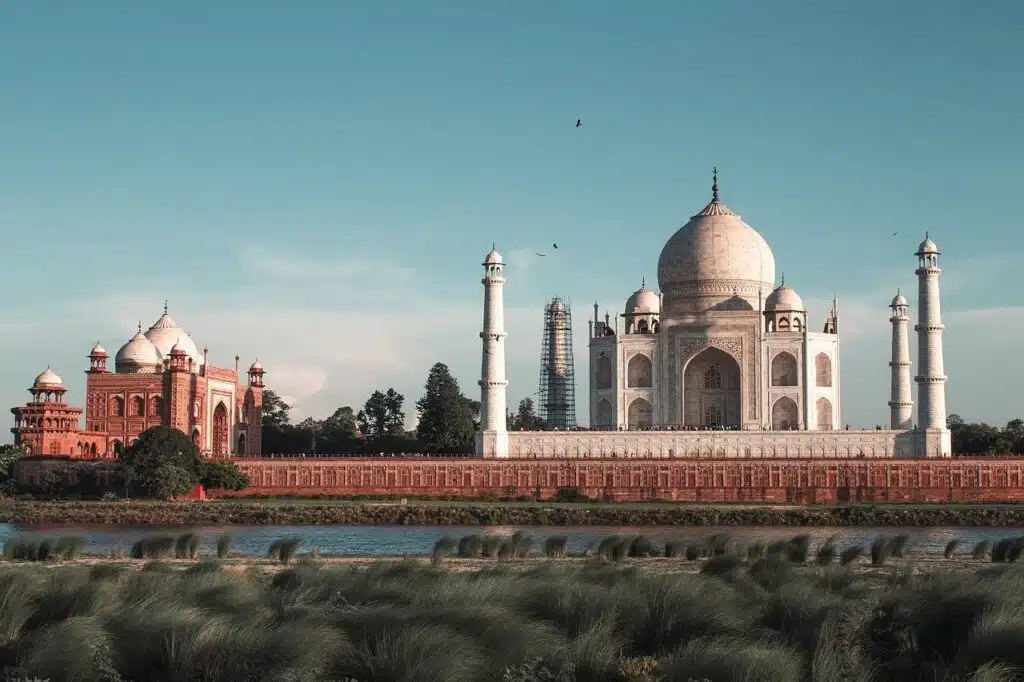Nestled in the heart of Agra, the Taj Mahal stands as one of the most iconic monuments in the world and a testament to eternal love. This breathtaking white marble mausoleum, commissioned by Mughal Emperor Shah Jahan in 1632, was built in memory of his beloved wife Mumtaz Mahal. As a UNESCO World Heritage Site and one of the Seven Wonders of the World, the Taj Mahal continues to capture the imagination of travelers from around the globe.
Why Visit the Taj Mahal?
- Architectural Marvel: The Taj Mahal is renowned for its stunning Mughal architecture. Its perfect symmetry, intricate marble inlay work, and the stunning central dome are a masterpiece of design and craftsmanship. The monument is adorned with beautiful calligraphy and detailed carvings, showcasing the artistic brilliance of its creators.
- Romantic Legacy: The story behind is one of enduring love and devotion. Shah Jahan’s deep grief over the loss of Mumtaz Mahal inspired this monumental tribute, which is often considered a symbol of eternal love. Walking through its gardens and reflecting pools, visitors can feel the profound sentiment behind this magnificent structure.
- Photographic Splendor: The Taj Mahal is a photographer’s dream. Its white marble façade changes color depending on the time of day, creating stunning photographic opportunities. Early morning and late afternoon light offer particularly magical views, casting a warm glow over the monument and its lush surroundings.
- Historical Context: Beyond its beauty, the Taj Mahal holds significant historical value. It is part of the Mughal heritage and reflects the grandeur of an empire known for its cultural and architectural achievements.

What to See and Do
- Main Mausoleum: The centerpiece of the Taj Mahal is the central dome, which houses the tombs of Shah Jahan and Mumtaz Mahal. The intricate marble work and the beautifully inscribed Quranic verses make this space awe-inspiring.
- Gardens and Reflecting Pools: The Taj Mahal is surrounded by lush gardens and reflecting pools that enhance its serene beauty. Stroll through these beautifully manicured gardens to enjoy the symmetry and tranquil ambiance.
- Agra Fort: Just a short distance from the Taj Mahal, Agra Fort is another UNESCO World Heritage Site worth exploring. This historic fort offers stunning views of the Taj Mahal from its ramparts and provides insight into Mughal history.
- Fatehpur Sikri: A visit to Agra wouldn’t be complete without a trip to Fatehpur Sikri, an ancient city built by Emperor Akbar. The complex includes impressive structures like the Buland Darwaza and the Jama Masjid, showcasing the grandeur of the Mughal era.
Best Time to Visit the Taj Mahal
The ideal time to visit is between October and March, when the weather is cooler and more comfortable. Early mornings are especially magical, offering a serene experience before the crowds arrive.
Travel Tips
- Tickets: Buy tickets in advance to avoid long lines. Foreign tourists need to purchase a separate ticket
- Dress Code: Visitors are required to dress modestly. It’s advisable to wear comfortable clothing and remove your shoes before entering the mausoleum.
- Photography: Photography is allowed in most areas, but ensure you respect the rules and avoid using flash inside the mausoleum.
The Taj Mahal is not just a monument; it’s an experience that touches the soul. Its breathtaking beauty and the poignant story behind it make it a must-visit for anyone traveling to India. Whether you’re a history enthusiast, a lover of art, or simply seeking inspiration, it offers an unforgettable journey into the heart of one of the world’s most romantic landmarks.














